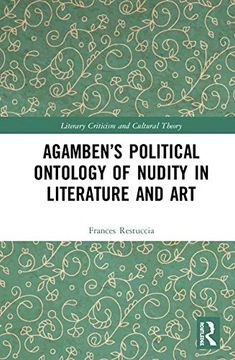Share
Agamben’S Political Ontology of Nudity in Literature and art (Literary Criticism and Cultural Theory) (in English)
Frances Restuccia (Author)
·
Routledge
· Hardcover
Agamben’S Political Ontology of Nudity in Literature and art (Literary Criticism and Cultural Theory) (in English) - Frances Restuccia
$ 144.00
$ 180.00
You save: $ 36.00
Choose the list to add your product or create one New List
✓ Product added successfully to the Wishlist.
Go to My WishlistsIt will be shipped from our warehouse between
Monday, July 15 and
Thursday, July 18.
You will receive it anywhere in United States between 1 and 3 business days after shipment.
Synopsis "Agamben’S Political Ontology of Nudity in Literature and art (Literary Criticism and Cultural Theory) (in English)"
This volume develops the central (though neglected) Agambenian concept of nudity along with its crucial political implications. The book discovers within The Use of Bodies a philosophical path to Agamben’s "ontology of nudity," as it is subtended by his notion of the messianic―a dual temporality of form in motion reflected in the image of a whirlpool that is autonomous although no drop of water belongs to it separately. Drawn from Paul and Benjamin (rather than Derrida), Agamben’s messianic is elaborated in this study through its embodiment in literature―Woolf’s To the Lighthouse, James’s The Aspern Papers, Brodsky’s Watermark, and Mann’s Death in Venice―in response to Agamben’s insistence on the wedding of poetry and philosophy. In particular, Coetzee’s Disgrace gives poetic form to Agamben’s focus on the dissolution of the human/animal border, the salvation of the unsavable, and "nudity"―all to illustrate Agamben’s Open without a closedness. This text shows how art serves as the house of philosophy also by taking up the nude in visual art, making the case that, in comprising chronos and kairos (the two messianic components of Agamben’s ontology of nudity), art demonstrates the constitution of form-of-life for the viewer. Emphasizing Agamben’s privileged non-unveilability/nudity, this book finally examines two major missed encounters, with Heidegger and Lacan, philosophers of the veil. Veiling to Agamben correlates with the sovereignty/bare life structure of the exception, which his ontology of nudity is meant to deactivate―as there is no such thing as a bare life.
- 0% (0)
- 0% (0)
- 0% (0)
- 0% (0)
- 0% (0)
All books in our catalog are Original.
The book is written in English.
The binding of this edition is Hardcover.
✓ Producto agregado correctamente al carro, Ir a Pagar.

